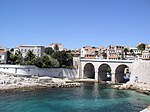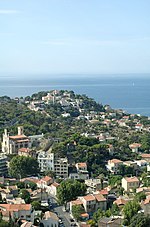Château d'If
1531 establishments in France7th arrondissement of MarseilleBuildings and structures in MarseilleCastles in Provence-Alpes-Côte d'AzurDefunct prisons in France ... and 10 more
Frioul archipelagoHistoric house museums in Provence-Alpes-Côte d'AzurInfrastructure completed in 1531Islands of Provence-Alpes-Côte d'AzurMonuments historiques of MarseilleMonuments of the Centre des monuments nationauxMuseums in MarseillePrison islandsThe Count of Monte CristoTourist attractions in Marseille

The Château d'If (French pronunciation: [ʃɑto dif]) is a fortress located on the Île d'If, the smallest island in the Frioul archipelago, situated about 1.5 kilometres (7⁄8 mile) offshore from Marseille in southeastern France. Built in the 16th century, it later served as a prison until the end of the 19th century. The fortress was demilitarized and open to the public in 1890. It is famous for being one of the settings of Alexandre Dumas's adventure novel The Count of Monte Cristo.
Excerpt from the Wikipedia article Château d'If (License: CC BY-SA 3.0, Authors, Images).Château d'If
Chemin de Saint-Estève, Marseille 7th Arrondissement
Geographical coordinates (GPS) Address Phone number Website External links Nearby Places Show on map
Geographical coordinates (GPS)
| Latitude | Longitude |
|---|---|
| N 43.279861111111 ° | E 5.3251388888889 ° |
Address
Château d'If
Chemin de Saint-Estève
13007 Marseille, 7th Arrondissement
Provence-Alpes-Côte d'Azur, France
Open on Google Maps








